Here to help. Our navigation page will take you to tags and posts about specific things. Be safe. Be strong. You are loved.
Don't wanna be here? Send us removal request.
Text

Today I want to introduce you all to Bunny Yoga - not the kind where you head out to a yoga studio and do yoga with bunnies climbing all over you, but cute little yoga routine graphics featuring bunnies performing each pose.
I absolutely love these little graphics, they're cute and fun pieces of inspiration, and the routines on them are almost always great for beginners.
All you need for yoga is a clear space and your body. A yoga mat is good, but it's not required. You can just as easily use a rug, a blanket, or a good towel. Wear some comfortable clothes, loose or stretchy enough for you to move in them, and pick a space where you have some privacy and safety, then just follow the routine. To get you started, try out the morning routine above!
Today's graphic supposedly came from yogaposes8.com, but I can't find the original image on that site any longer, and I'm not sure who actually drew the images. If you know, or if the art is yours, please let me know so I can give the artist proper credit!
#wellness wednesday#wellnesswednesday#wellness#yoga#health and wellness#mental health#physical health
1 note
·
View note
Text
Mindful Monday: Meditative Walking
This was something I loved doing as a teenager. Not too far from where I lived was a park that had a meditation labyrinth inscribed in one of the little squares. The idea was to follow the path from the outside to the inside, focusing on your breathing and steps and allowing your mind to quiet down. If you feel like traveling, try finding a meditation labyrinth near you - you can use this site for some easy searching: https://labyrinthlocator.org
If you live in Minnesota, the labyrinth I used to walk is located at Como Park, right by the pedestrian bridge! This labyrinth was created in honor of Saint Paul's sister relationship with Nagasaki.

If you DON'T want to travel, that's okay! You can very easily do some meditative walking on your own property, either indoors or outdoors.
Start by clearing a space if you're inside, or head outside to your yard or patio if you have one. If you need a guide, you can make your own little path with string, chalk, rocks, rope, or even pillows if you have a bunch. A good path/pattern to follow is a circle or square that moves inward with every loop.
When you're ready to start walking, take a deep, slow breath, and take your first step. Walk at a leisurely pace, and make every step intentional - by this I mean put your foot forward and down with clear thoughts of moving forward. Keep your breathing steady as you go, one step at a time, from the outside of your path to the center. Whenever your thoughts begin to stray, gently pull them back to your next step, or your next breath. At the center point of your spiral, pause for a moment. Take another deep breath and check in with your body. Make yourself aware of how you're feeling, physically and emotionally. Breathe again, then start walking again, this time following the path from the center to the outside.
When you're finished, ideally your mind will be quiet, and you'll be prepared to face whatever comes next! Give this a try any time this week and let us know how it goes
#mindfulmonday#mindfulness monday#self care#mental health#meditation#meditative walking#labyrinth#meditation labyrinth
1 note
·
View note
Text
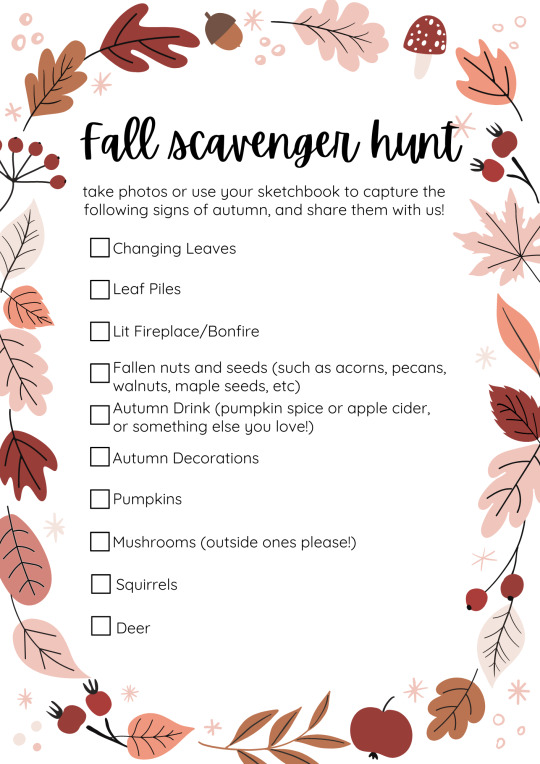
Hello everyone, it's been a while, hasn't it? I apologize.
And as part of my apology, I present today's Mindful Monday activity! I'm changing things up this month to see if I can't work out a schedule that works for me a little better, and that means more activity-based posts!
Today I challenge anyone who finds this post to grab a camera, phone, or pencil and sketchbook, then head out into the world and seek out items from this scavenger hunt list!
Scavenger hunts are a wonderful tool for mindfulness - they encourage you to connect with the natural world around you, which often has a positive effect on mental health, and they can also be great for stimulating creativity!
Once you've finished your hunt for the day, please tag this blog in any posts you share on your own blog! Or, if you'd rather do this on Twitter, please use the hashtag #MMAutumnScavengerHunt so I can find your posts and see what you came up with!
#mindfulness monday#mindfulmonday#scavenger hunt#autumn#mindfulness#nature#mental health#photo challenge#art challenge
2 notes
·
View notes
Text
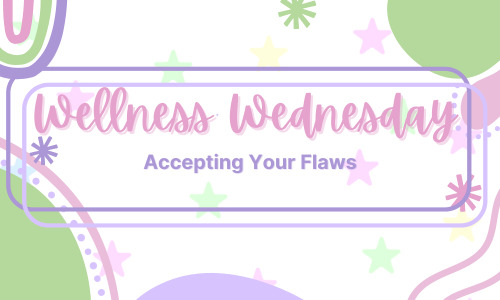
Hello everyone, and I hope you're all having a wonderful Wednesday so far!
Today we're going to talk about something difficult: Accepting our flaws.
Before we really get into it, let's talk about what acceptance means, particularly in this context. If you're anything like me, you might have a mental illness or other disorder, and you might have had a thought similar to, "I already DO accept my flaws, my flaws are on my mind all the time, I know exactly what's wrong with me!"
And while this might be true, let's tackle that knee-jerk response.
A lot of people, neurodivergent and neurotypical both, tend to struggle with something called Negativity Bias. This is what happens when you find yourself focusing only on the things that go wrong in your life.
Let's say you have an exceptional day: you do great at work, the drive to and from anywhere is traffic free and all the lights are green, you managed to get the very last of an item on the shelf. Your luck is great! And then you get home only to find your pet has peed on the floor.
In a healthy scenario, you would clean up the mess and take measures to make sure it doesn't happen again, and that's it. You finish your day in a good mood, proud of what you accomplished for the day.
For someone experiencing negativity bias, that brief dark spot on the day, the pet peeing on the floor, defines the entire day. It doesn't matter that it's almost the end of the day. The dog peed on the beautiful hardwood floor and now you have to get out the paper towels and the mop, and it becomes a whole production. By the time you're finished cleaning up, maybe only a few minutes have passed, but it feels like hours. You start to question why you even have a pet, what did you do wrong to make your beloved animal pee on the floor, why does Fido hate you so much?
Someone asks you how your day was and instead of focusing on all the great things that happened, all you can think about is the dog peeing on the floor.
Now, this is a bit of an extreme example, but I think it illustrates the point well: that someone struggling with negativity bias is going to be more easily tripped up by bad luck, or getting something wrong on the first/second/third try. A bad customer will ruin their entire week. A mistake on a test becomes a threat to their whole grade.
Negativity bias can very quickly snowball into the distorted thoughts of catastrophizing.
To avoid that, I try to practice accepting my flaws, the focus of this post!
Now, accepting your flaws doesn't mean using them as an excuse or to get out of things. For the most part, flaws can usually be repaired, or at the very least worked around. But in order to repair or work around your flaws, you have to identify them and accept them.
Sometimes, things that we think are flaws aren't really flaws at all. This exercise can also help you identify things that are normal/natural, and don't need to be "fixed".
So let's start:
First, get a piece of paper, and write down ten things that you don't like about yourself (yes, I know that many therapists discourage this, but please bear with me!)
Next, I want you to review your list and fact check it. By this I mean, is this flaw really something that applies to you, or is it just something that you think applies to you?
For each of the things that you wrote down that you're sure are true, I want you to think of someone else that you know who has the same "problem". When you think of that person, think about if the thing you don't like about yourself is something you do like in another person, or if it's genuinely something you don't like.
For each thing you identify as not a flaw in someone else, I want you to think about why it's such a bad thing in yourself. Why are you holding yourself to a standard that you don't hold others to? Think about when you started to see this as a flaw in yourself, and what happened to make you think that way.
For each thing you identify that you do feel is also a flaw in other people, I want you to think about what you don't like about it, and ways that you might be able to improve on it in yourself.
I'll start you off with my own list as an example. This example is the last part of the post, so if you don't want to read it, you're done! Have a wonderful day everyone!
Ten things I don't like about myself
I sleep a lot
It takes me a long time to complete tasks
I'm very overweight
I don't have a real job
I have short, chubby fingers
I drink too much soda
I eat too many sweets
I'm a bad pet owner
I'm a slob
I'm disorganized
Are these things objectively true?
According to my time tracker, I usually sleep between 7 and 9 hours a day, which is pretty much normal.
It takes me an average amount of time to complete a task - the reason it feels like tasks take me a long time is that I often struggle to start.
Based on my BMI, I am clinically obese, yes.
A "real job" is subjective. Some people think that any job that pays is a "real job" and some people think that you have to have a job with more prestige for it to be considered "real". However, I am currently unemployed after 7 years as a live in caregiver.
My fingers and hands are proportional, based on anatomy classes that I took in college.
I drink between 2 and 4 cans of cola daily
I eat "dessert" foods - such as cakes, candies, and ice cream, 3-4 times a week when I have them in the house
I love my animals and they are healthy, but I do struggle to keep up with some of their daily care tasks.
I struggle with pest control, but rarely leave garbage out for longer than a day or two.
My house is cluttered and I sometimes struggle to find things I know that I have.
Comparing my flaws to others
Not a flaw
I have several friends with ADHD who struggle to start and complete tasks in a timely manner like I do. They seem to struggle and get frustrated as much as I do.
Most of my family is obese, especially on my dad's side. I've always loved them regardless, and looks have never influenced how I feel about other people.
Not currently a flaw
Not a flaw
My uncle and my mom also drink a lot of soda. While it doesn't bother me that they do, I think I definitely still consider it a flaw in them as well as myself.
I know plenty of people who eat much more than I do, and I know people who would never touch the foods I indulge in. I'm not sure if I still consider this a flaw or not.
I had a friend in college who almost never took their dogs for walks and just kept potty pads in the house for them to go potty most days. Their older dog was locked in one room almost 24/7 after the new dog was brought home. While my situation isn't quite there yet, it's a concern that I have and want to address.
Pest control is a common issue in my area and it doesn't mean that I'm a slob. This is less of a personal flaw and more of a situational problem that I can address.
My mom was always very organized when I was young, and when I got older she became more and more disorganized and seemed to not care about the home anymore. It always bothered me and made me worry about her.
Ways to improve
Not a flaw
Work on time management and look into resources for ADHD that emphasize executive dysfunction and task completion.
Try to be more active and focus on feeling good rather than looking good.
Not currently a flaw
Not a flaw
Re-introduce water to my diet and try to cut back on the cola. Keep in mind that caffeine is literally a drug and caffeine withdrawals may suck but can be managed.
I need more time to think about this one and to consider my overall diet as a whole.
My biggest concerns are fleas and my cats' potty behavior. I've started them on flea medicine, and I need to make sure to keep their litterboxes clean. I might also need to consider saving up money for a vet visit just in case, as at least one of them might be suffering from a UTI that is causing the potty problems.
Once I declutter the house and toss out all of the cardboard boxes we used for moving, there should be a significant drop in pest problems, as most of their hiding places will be gone.
Tackle each room one at a time and get things tidied up. We have a lot of things that either aren't ours (inherited through multiple moves and housemate changes) or that we just don't need anymore.
0 notes
Text

Popcorn is a really great snack for just about everyone! It's a whole grain option for those who prefer that, it's easy to make, and there are so many different ways to customize it! I've gathered up some of my favorite popcorn flavoring options here!
For the best results, you want to start with plain popcorn. Most bagged popcorn is salted at minimum, and a lot of the bagged stuff has butter or other flavoring, so keep that in mind if you decide to start with microwave or pre-popped corn. My personal recommendation is to get stove-top popcorn. It's very easy and there are options available to be able to microwave that as well if you don't have a stove.
Safety warning: Please remember that while popcorn is a healthy, tasty snack, it's not suitable for infants or toddlers, as it poses a choking hazard. Be safe!
Alright, into the flavor recipes we go!
Start by making your popcorn! All of the below recipes assume that you've made about 5 cups of popped corn (1/4 cup unpopped kernels), which is about 2-3 servings. If you make more, make sure to increase your measurements!
Savory Recipes
Classic Movie Theater
1/4 teaspoon salt
1 tablespoon butter
Cajun-Spiced
2 tablespoons butter
1/2 teaspoon paprika
1/2 teaspoon lemon pepper
1/4 teaspoon salt
1/4 teaspoon garlic powder
1/4 teaspoon onion powder
1/4 teaspoon cayenne pepper
Buffalo
1/4 cup sugar
2 tablespoons water
2 tablespoons wing sauce
1 1/2 tablespoons butter
1/4 teaspoon baking soda
1/8 teaspoon cayenne pepper
Ranch
1/2 teaspoon onion powder
1/2 teaspoon dried dill weed
1/4 teaspoon garlic powder
1/4 teaspoon salt
1/4 teaspoon black pepper
1/4 teaspoon vegetable oil
Italian-Style
1 tablespoon olive oil
1/4 teaspoon onion powder
1/4 teaspoon garlic powder
1/4 teaspoon oregano
1/4 teaspoon rosemary
1/4 teaspoon thyme
1/4 teaspoon sage
1/4 teaspoon parsley
1 cup parmesan cheese (freshly grated is best)
Doritos
2 tablespoons nutritional yeast
1 teaspoon salt
1/2 teaspoon ground cumin
1/2 teaspoon garlic powder
1/2 teaspoon onion powder
1/2 teaspoon paprika
1/2 teaspoon chili powder
Sweet
Winter Holiday
2 ounces white chocolate, melted
1/4 cup crushed peppermint candy
Chocolate
1/4 cup sugar
2 tablespoons butter
1 tablespoon corn syrup
1 tablespoon cocoa powder
1/2 teaspoon vanilla
If you don't mind taking some extra steps, I also recommend this Caramel Corn and this Cinnamon Roll Popcorn recipe!
Have a wonderful day everyone!
0 notes
Text
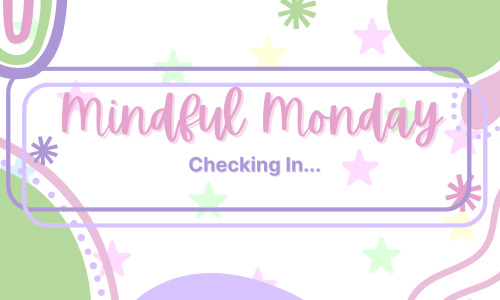
Hello everyone! It's been a couple weeks since I last saw you all. I was struggling with keeping my own self care up, so I had to take an unscheduled break. I apologize for not giving a warning!
Today we're going to ease back into things with a nice and simple check in. If you're seeing this post on your dash, take a few moments to pause and check in with yourself.
How is your body feeling? How are you doing mentally? If you're feeling off at all (and even if you're not) take a break with us for a moment.
If you've been sitting for a while, take this moment to move back from the screen and stretch. Lift your arms over your head and reach as high as you can! Do a few good neck rolls (that is, rotate your head forward, to the side, back, and to the other side a few times). Roll your shoulders and feel them loosen up.
If you're able to stand, do that now. Stretch your legs either way.
It's a little after lunch time in my part of the world, have you eaten yet? Go ahead and grab yourself some food if you need it, and get a drink too while you're in the kitchen. Your body needs fuel and hydration after all. We'll be here when you get back!

Welcome back! I hope that the break helped you feel a little better today. Check in with us tomorrow for a delicious recipe for Tasty Tuesday~
0 notes
Text
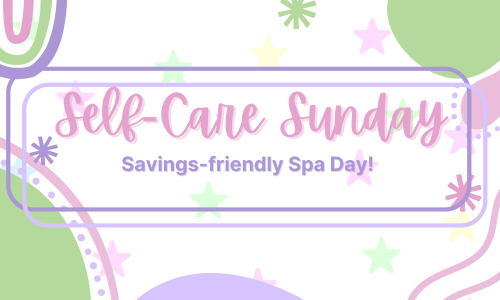
Hello everyone! I know I went missing for about a week, my apologies. I'll talk about it a bit more with tomorrow's check in. For today, let's focus on some self-care!
For this month, I'm focusing quite a bit on "fun" self-care. We've had a few posts now talking about the importance of the harder tasks involved in taking care of yourself, and this month I know that I personally need to put some heavy emphasis on being kind to myself. So I want to share that with all of you.
A "consumer" spa day - a day where you go to salons or massage parlours or commercial spas - can be very, very pricey. Manicures alone are running between $25 and $60 in my area, depending on who you go to, and adding in foot care, facials, hair care, massage, and more makes the register ring up higher and higher, which I know not everyone can afford. I sure can't! So instead, let's think about what we can do at home with things that we have. If you don't have the following supplies, that's okay! Use what you do have, and if you have money available for indulging, swing by a dollar store - no one wants to admit it, but a lot of their stuff is fairly good quality!
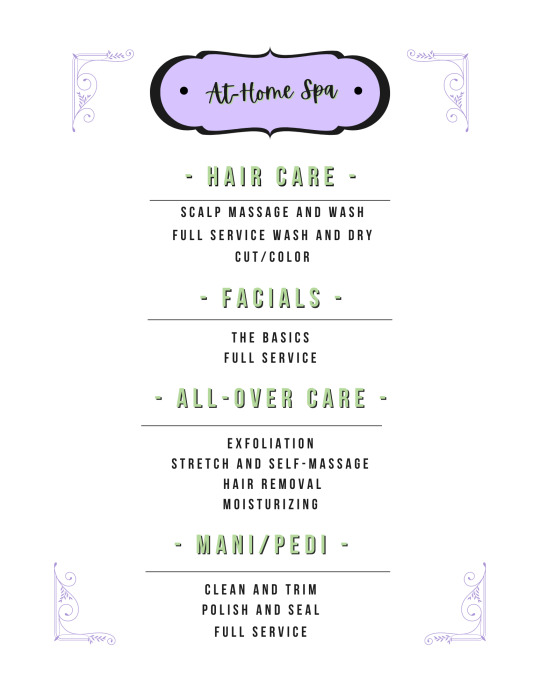
The first thing you want to do is make yourself a menu, like the one above! This one is just an example, I don't do all of this for my spa days, but it gives you a good idea of what your possible options are.
Once you've set up your menu, make a list of supplies you need for each treatment. My list is below, but your list may be different depending on your skin and hair type, and your personal hygiene preferences!
Hair Care - Shampoo - Conditioner - Hair Dryer - Box Dye - Vitamin E Oil
Facial - Exfoliant - Cleanser/Soap - Toner - Lotion - Toothbrush/Toothpaste - Floss
All-Over Care - Exfoliant (soap and/or cloth) - Body oil (I like peppermint in the morning or lavender at night!) - Depilatory cream - Lotion
Mani/Pedi - Nail kit (minimum clippers and file) - Soap - Lotion - Vitamin E Oil - Nail Polish - Top Coat
I tried to keep my list pretty general, but I know that I would be buying very specific items because of my eczema, skin type, and allergies. So make sure that your list accommodates your specific needs, okay?
Some other things to make your spa day extra luxurious:
Candles, incense, or scent diffusers (if you have pets or allergies, keep that in mind while choosing your scents/oils!)
Face masks
Cooling or heating packs (good for soreness and inflammation)
Curling iron/hair straightener for styling fun
Hot tea or hot cocoa
Sweet treats - baked goods or chocolates are great for spas
I recommend setting aside between 1 and 3 hours for your pampering session. You want to give yourself time to relax and enjoy it after all. Have a wonderful rest of your weekend everyone, and I'll see you tomorrow!
1 note
·
View note
Text

Note: This post contains Amazon affiliate links, and I make a small commission if you buy through them.
As we creep up on the end of the month, I wanted to think about different savings tricks and methods. One that I've noticed has become pretty popular over the last couple years is cash stuffing.
For those who don't know, the idea behind this is that you withdraw an amount of funds as cash and bring it home, then divide that cash into different envelopes or folders for different things you might be saving/budgeting for.
This might also be called envelope budgeting or "the envelope system".
For cash stuffing, all you need is cash and some envelopes. On each envelope, you write down a specific goal or category. Common ones are:
Clothes Shopping
Vacation
Take Out
Hobby Supplies
Fun
Keep in mind that you can use cash stuffing just for savings goals, OR you can use it for your entire budget system, including rent, bills, groceries, etc. Just remember that this is meant to help you, so if it's easier for you to pay your bills through debit/credit, make sure to leave enough money in your account for those things.
This is an example of a commercial budget binder than uses labels and envelopes (although the "envelopes" in this case are plastic sleeves rather than actual envelopes).
And here is an envelope set from Clever Fox, a planning brand that I'm very fond of. The envelopes in this listing have spots for you to not only name the category, but also track your budgeted (planned) and actual funds used for that category each month.
While the cash stuffing method is trendy right now, it's not new, and there's actually a fair bit of psychology behind it.
Neurodivergence
Some people struggle with budgeting for different reasons, but a common issue, especially for those of us with neurodivergent minds, is that the money in our bank accounts is too abstract. We see the number in the account and we know what it means, but for some people there's still a disconnect in the mind about how much money is actually available to spend.
Using a cash method when feasible allows people who struggle with digital money to hold their funds in their hands, and completes that connection of "this is what I have" to "this is what I can spend". Dividing that physical cash into clear categories, labeled and separated, also helps with that connection.
Age
A cash method for spending/budgeting is also a great way to teach your children about money. Many people might mock parents who give their kids "allowances" and "charge them rent", but in many cases these parents have just set up a system that works for them and their kids to teach the children how spending works.
Personally, I think it's a really good idea. Starting your kids early with something low stakes like a $20 monthly allowance and, say, $3-5 "rent" shows them how to budget long before they have to face that concept in the real world.
Plus, kids love to do things that they see their parents doing - that's why children love kitchen sets and toy grocery stores so much!
Family
My last major reason for suggesting the cash stuffing method is that it's a good way to get the whole family on the same page if you share funds. How you determine "whose money is whose" is your business, of course, but if you have a family fund, using the envelope method can help identify clear boundaries and limitations on spending. You can also use this as a family activity - every week, two weeks, or month, the family all sits down together to work out the budget.
Whatever reason you might have to try this budgeting method, if it works for you, let us know! And if it doesn't, let us know that too, and why!
#finance friday#financefriday#cash stuffing#envelope budgeting#budgeting#budget planning#self care#financial wellness
0 notes
Text

Today's Thankful Thursday exercise is to write a letter of gratitude. You don't have to send it if you don't want to - you don't even have to address it to a single person, or a real person.
For example, I regularly write letters to an angel, who I tell about all the things that are going on in my life. It's not quite prayer, and there's no structure to it, but having a solid entity that I address helps a lot with getting out the thoughts.
So, let's get started!
Step 1: Identify your target
As you may know, all letters start with a salutation. If you're writing your gratitude letter to a specific person, you would write "Dear Aunt Sally," for example, or "Dear mom". If you would prefer to write your letter to an entity, you can try "Dear God," or "Dear Frodo Baggins," or any other being of religious, cultural, or fandom/hobby significance to you.
You can also go with "Dear Diary," or "Dear Journal," if you'd like to keep this letter in your private journal. The idea here is to have a target that you're addressing, whether you intend to pass this letter along or not.
Step 2: Determine your format
If you're writing this letter to a specific person, then the format of your letter is going to center on what you're grateful to that person for.
"Dear mom,
Thank you for always being there for me. I'm so grateful for the way that you have my back in difficult situations, and how you stand up for me when I struggle to hold my own."
If you're writing in more of a diary/journal format, the letter will look a little different. It will be more general and broad, rather than focusing on a single person.
"Dear Diary,
I'm thankful for the bright sun today. The good weather made it easy for me to go out and spend some time with my friends at the park. I had a lot of fun that I might have skipped if it had been cloudy or raining."
And if you're addressing your letter to an entity, a higher being that you don't necessarily interact with one on one, or even a fictional character, you could pick either of these formats, or combine them.
"Dear Mr. Baggins,
Thank you for being the sort of character that I can admire and draw inspiration from. Today I went out with some of my friends, and while we didn't go on a long journey across the continent to save the world, we still had a lot of fun, and being so familiar with your story made me appreciate what I get to have and experience even more."
Just remember, a gratitude letter is different from a gratitude log - you don't have to write the letter like a list of things you're grateful for. Just talk about things that went well, that you appreciate, and that you want to call attention to as being positive.
Step 3: Write the Letter
Now that you've decided who you're writing to and how you're addressing them, all that's left is to write the letter. Try to narrow the focus in to a single incident or event if you can. Even if you're writing to someone and you feel that you have a lot to thank them for, or that your thanks are long overdue, you don't want to go on too much of a tangent - that way lies choppy waters. My recommendation is to write 1-2 pages. Less than that and you're not getting the full benefit of the exercise, and more than that and you might get overwhelmed or stress yourself out.
You can do this! And I'll see you all tomorrow for Finance Friday~
#thankfulthursday#thankful thursday#gratitude#gratitude letter#thank you note#letter writing#self care#mental health#health and wellness
3 notes
·
View notes
Text

Today let's talk about environmental awareness.
I'm not talking about things like nature preservation and animal protection, although those are important. No, today I'm talking about being aware of your personal environment, and how it affects your physical and mental health.
A lot of people, especially those of us in lower income situations, often miss environmental cues that might be affecting their health, especially if it's a situation they're either used to or can't do anything about (if you're a minor, or if you just don't have the funds available, this can be a huge struggle).
Still, being aware of these issues and identifying the changes you can make in your situation can be helpful.
So today I want to do an exercise with you - yes, with you! Grab a pen and a notebook or notepad, and let's do a house walk through together. In your notebook, I want you to write down what room your in, then take a look around and make note of anything in the environment that's wrong or off. And I do mean anything - you can take a look at my notes below for ideas!
After you've done this for every room (or every room you have access to), come back to this post for the next step.
Take your list and your pen (if you want, you can use different colored pens, or stamp markers even) and mark down which things on the list you can fix now, which you can fix later (if you need money or supplies), and which you can't fix (because you don't have access to the resources).
Use this list to make a plan for yourself, and every day for the next week, I'd like you to try doing at least one thing on the list. See how it makes you feel to get those things done.
Keep in mind while you're looking through my list that your list may be much shorter - that's not a problem! My list is very long because I have a year's worth of work to catch up on still.
Anyway, here's my list, written using an Alastair system. The first column is "N" for now, second column is "L" for later, third column is "⊘" for things I can't do (due to this being a rental). The fourth column is my actual task list.

#alastair method#self care#mental health#health and wellness#wellness wednesday#wellnesswednesday#environmental wellness
0 notes
Text

Hello everyone, welcome to another Tasty Tuesday!
Today I decided we should try out some candied fruit. It's pretty easy to make, it's delicious and has a nice chewy texture, and you can use any fruit you want!
I've got two options for you:
Option 1: Dried Fruit
When most people think of candied fruit, they think of one of two things - either candied/caramel apples, or tanghulu. That's not the route that we're going today (but you should look into both because they're also very yummy!)
Today we're talking about dried fruits!
Start by choosing your fruits. You want fruit that is firm and mature - try to avoid anything bruised or overripe/soft, and if your fruit isn't quite ripe yet, give it a little while longer to ripen.
Once you've picked out your fruits, it's time to peel and slice. (Note: most fruits don't have to be peeled for this. If you normally eat the skin/peel, you're good to leave it on!) To keep your fruit from browning or losing color during the drying process, soak your slices in either lemon juice (full strength or diluted with equal parts juice and water) or ascorbic acid (8 tsp or 36g per quart/liter of water) for 5-10 minutes.
I recommend slicing your fruit no bigger than 1/2 an inch, or about 2cm.
If you don't have a dehydrator, pre-heat your oven to 200F (93C). Line a baking sheet with parchment paper and lay out your fruit slices. Put the fruit into the oven for 4-8 hours (this is going to vary depending on the starting water content for your fruit. You'll have to check on the fruit at regular intervals to see how it's doing).
If you have a dehydrator, you can put the fruit on mesh sheets at 135F (53C) for 8-12 hours.
You'll know when the fruit is done when it looks shriveled and has a chewy texture.
At this point, you can gather it all up to store in an airtight container, OR you can drop the dried slices into a 1 gallon zip top bag with sugar, and shake to coat. Doing this step while they're still warm means you don't have to add additional moisture, and you get that nice grainy texture (I love that texture!)
As long as your fruit was fully dehydrated, you can store it at room temperature for about a year. If you want to keep it longer than that, I'd recommend other preservation methods like jams/jellies and canning.
Option 2: Fruit Leather
Fruit leather is a lot like the previous method, but with some extra steps and ingredients.
First step, once again, is to pick your fruits. This time if your fruit is a little overripe, that's okay.
Wash your chosen fruit, then peel and remove the pits/cores. While the dried fruits above could keep their skins, you should really peel them for fruit leather. Chop your fruit into chunks.
In a large saucepan, add 1/2 cup of water for every 4 cups of chopped fruit. Bring the fruit to a simmer, then cover and cook on low heat for 10-15 minutes. Uncover the pan and use a potato masher or a wire whisk to mash the fruit in the pan.
At this point, you can decide what additions you want. If you chose a lot of very tart fruit, you might want to add sugar. You can do this 1 tablespoon at a time until you're happy with the sweetness.
If the flavor seems a little muted or bland, try adding lemon juice 1 teaspoon at a time to brighten up the flavor.
You might also want to add spices like cinnamon, nutmeg, ginger, cloves, or allspice.
Continue to simmer your mix until any added sugar has dissolved and the puree has thickened, another 5-10 minutes.
In a blender or food processor, puree the fruit mix until it is completely smooth. You can check the flavor again at this step and make any additions, using the blender/processor to thoroughly mix them in.
If you have a dehydrator, you can pour the puree into your trays lined with parchment paper and dry them on the machine's fruit setting.
If you don't have a dehydrator, preheat your oven to 180F (82C) and line a baking sheet with parchment paper and spread the puree about 1/8 to 1/4 inch thick (1/2 to 1 cm) over the pan. Place in the oven for 8-12 hours, until the leather is no longer sticky to the touch.
Use a pizza/rotary cutter or kitchen shears to divide the leather into long strips, then roll it up and store in an air-tight container (to make it easy, make sure that you cut through the parchment paper as well and roll the leather on that. It'll be super easy to unroll later!)
Store your fruit leather at room temperature for 1 month, in the fridge for 6 months, or in the freezer for 1 year.
I hope you enjoyed, and let me know if you try these recipes/ideas!
0 notes
Text
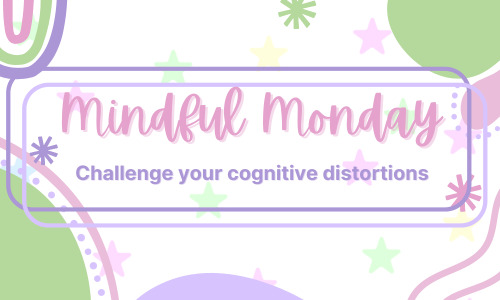
Today we're focusing on cognitive distortion! Exercises involving cognitive distortion are very commonly recommended for people struggling with personality and mood disorders. If you've ever talked with a therapist about cognitive or dialectical behavioral therapy, this might have come up.
At the end of this post, you can find links as usual!
Cognitive Distortions
These are biased thoughts that affect how you see yourself, others, and the world around you. They are typically exaggerations of things that were actually said or that happened, which your mind twists into something (usually worse) than it actually is.
The common distortions are:
Overgeneralization Making broad, negative conclusions that are far outside of the scope of what the situation indicates (Key Words: "always", "never", "everything", "nothing")
Mental Filters Similar to "tunnel vision", this distortion involves focusing on small, negative details rather than the big picture, which is often more positive
Discounting the Positive While with mental filters you may ignore the positive details, with this distortion you acknowledge the positive, but dismiss it as being insignificant or having little value
Jumping to Conclusions Determining the reason or result of a situation without gathering all of the information first
Mind Reading Making assumptions about what another person is thinking, or the reasoning behind their behavior
Predictive Thinking Assuming how a situation or conversation will go or end before actually engaging in the situation
Magnification Disproportionately reading the positive and negative aspects of a person or situation. Most typically: magnifying your own negative traits and minimizing your positive traits, while also magnifying another person's positive traits and minimizing their negative traits
Emotional Reasoning Making assumptions based on your emotional state or gut feeling, even if the reality doesn't match up with the assumption
"Should" and "Must" Statements Putting unreasonable demands or pressure on yourself or others. (Key Phrases: "I shouldn't struggle with this", "I/They should know better", "I must get this right")
Labeling Assigning labels to yourself or others that make general statements based on specific situations (Key phrases: "I'm such an idiot", "They are selfish")
Personalization and Blame Blaming yourself for a situation going wrong, or attributing other people's behavior to being your fault or caused by you (Key Phrase: "It's all my fault")
Catastrophizing Turning a small negative situation into a disproportionately larger problem, "making a mountain out of a molehill"
Black and White Thinking Also called all-or-nothing thinking, this is when you only see one extreme or another. Everything is given clear categories in your mind of "good" or "bad", "right" or "wrong" with no room for anything in between
You can use these two free printables to work on identifying your own cognitive distortions and working through them!
Cognitive Distortion Reference Page
Cognitive Distortion Worksheet
1 note
·
View note
Text
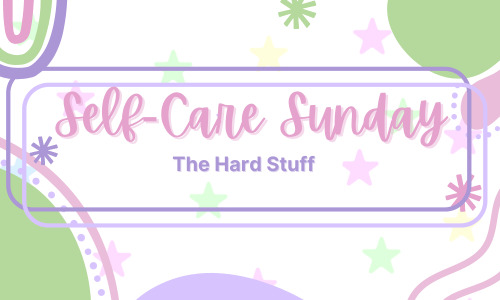
Sometimes wellness blogs focus so much on making self-care and wellness look fun and aesthetic, that they forget to even talk about the hard part of self-care. Or perhaps they choose not to, because they don't want to or aren't ready to discuss the struggles that they battle every day.
And that's okay, but it's important to remember that those hard parts do exist.
Today I want to talk about the hard tasks involved in self-care.
Before we start, I want to make it very clear that the purpose of this post is not to put pressure on you. My goal here is not to invoke guilt, self-hatred, frustration, or shame. Firstly because this is, first and foremost, a Safe Space, and secondly because causing those emotions is not going to help you.
That said, if you find yourself feeling any of those things while you read this post, I encourage you to take a break, get a drink or snack, and come back to this later.
The Dark Underbelly of Self Care
That sounds ominous, doesn't it? I wanted to drag a little humor in here kicking and screaming to make this easier. It's not easy to talk about these things, and I'm sure it's not easy to hear about them.
This past week, readers may have noticed that I struggled with posting. That wasn't the only thing I struggled with - this was a bad week for me, and that's why I chose this topic for today.
I'll break the post down into my usual self care categories, and you can decide which ones are your weakest and focus there, or you can read the whole thing. It is a bit long though, I apologize.
Physical
Physical self care means taking care of your body. When we focus on the bright and beautiful side of things, this means spa days, nice food, and plenty of rest.
What else? What else does your body need to be healthy? Things that might be hard for people with mental illness to do on a regular basis include:
Showering
Dental Hygiene
Medication for physical illness (diabetes, chronic pain, thyroid conditions, high or low blood pressure, etc.)
Eating balanced meals
Getting plenty of hydration (preferably water)
Getting out of bed
Mental
Mental self care is about keeping your mind sharp. You might do this by doing puzzles, playing strategy games, or taking classes to learn new things.
The hard part of mental self-care is that people with mental illness often struggle with memory loss, confusion, aphasia (being unable to think of common words), and creativity, or lack thereof.
It's important to keep up with thought and creative activities to maintain your mental wellness, even when it gets frustrating.
Try:
Taking a class
Choose something to research on your own time
Complete word puzzles (like crossword), number puzzles (like sudoku), or cryptograms
Creative challenges like prompt lists, "30 days of...", or art games like pictionary
Emotional
A lot of self-care blogs (myself included at times) will focus on things that make you feel good. But if you're struggling with emotional wellness, you also have to remember...
Taking medications (like antidepressants, antipsychotics, mood stabilizers, etc.)
Practicing mindfulness and grounding exercises
Acknowledging your mistakes
Apologizing for causing other people distress or pain
Taking responsibility for your actions - even accidents and actions performed while under the influence or during an "episode"
Reaching out for help
Attending therapy or counseling sessions
Social
Social self care can sometimes be the hardest one to advocate for. Some people may take a "focus on yourself" approach, which emphasizes setting boundaries, saying no, and blocking out time for solo activities. Some people take a "reaching out" approach, focusing on building relationships, engaging in social activities with friends, and developing family bonds.
The hard part of social self care is balancing it all. We all have different social needs and tolerances, and developing social care skills is going to be difficult if you're trying to follow someone else's formula.
Hard social self care can include:
Setting boundaries and enforcing them
Reaching out for help
Saying "no" to requests
Balancing solo time with social time
Stepping away from social media
Saying "yes" to events and activities
Leaving the bubble of your comfort zone
Spiritual
Spiritual wellness is all about finding your purpose in life and developing your morals. If you're in a spiral of not knowing what to do, what the point of living is, why you should even try, you might need to focus on some spiritual care.
This doesn't have to be religious, and none of my listed suggestions are religion-locked. Give some of these a shot, even if they're a challenge for you.
Volunteer
Meditate
Keep a journal
Practice forgiveness
Donate to a cause, if you have the funds
Environmental
Environmental wellness is the hardest one for me. This involves keeping your home clean enough to be a healthy place to live, and it can be frustrating. For environmental self-care, please remember to:
Wash the dishes
Take out the trash
Sweep/Vacuum/Mop regularly
Put away things that have been sitting out (declutter)
Treat your home for pests
Clean your windows and open the shades during the day (if it's not too hot)
Change your HVAC filters every 1-3 months
Clean up after your pets
Many of these activities can be beneficial for multiple categories of care, and you may need or struggle with some of them more than others. That's alright. Struggling means that you're still learning, still developing an understanding of your needs.
Please remember to take care of yourselves, and I'll see you tomorrow.
1 note
·
View note
Text
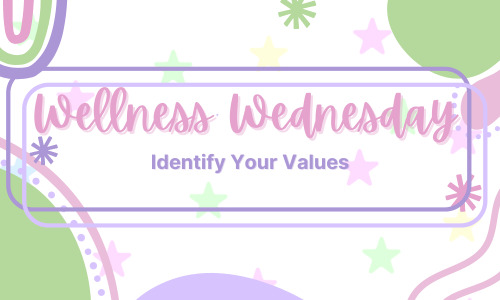
It's still technically Wednesday somewhere in the United States! I'm not late, you're late.
All joking aside, today I want to talk about spiritual wellness. This is an aspect of wellness that can sometimes be overlooked, as the word "spiritual" is often associated only with religion. If you have religious trauma, or just prefer to live a life without religion, the idea of "spiritual wellness" might put you off.
This aspect of wellness is not necessarily religious, however. Spiritual health is focused more on your personal purpose in life, whether you're sure about it or not, and your morals and values.
Today I want to focus on identifying your personal values. I don't have a worksheet for you this time around, but I may edit one in later. For now, we can just review the steps together. You might want to grab your journal for this!
Your values are all about who you are, and who you want to be. Identifying your personal values is a great first step in self-discovery, and can help you to better understand the metrics and standards that you use to judge yourself. That's helpful for reducing negative self-talk and being kinder to yourself.
Step 1: Identify times of happiness
Think back on your life, and focus on some happy memories. It's best if you can identify some in both your work and personal life. Try to focus on the who, what, where, and when - that is, who were you with, what were you doing, where were you, and when in your life did it happen?
Step 2: Identify times of pride
Like in the previous step, you want to identify your who, what, where, and whens. This time, however, focus on memories where you felt proud. Think about your accomplishments, the "wins" in your life. It could be a promotion, an award, landing your dream job, graduating, having/adopting a child - anything that made you feel proud, write it down and include your Ws.
Step 3: Remember times that you felt fulfilled or satisfied
Following along with the previous steps, this time you want to identify your Ws for memories when you felt fulfilled or satisfied. This is a sensation that can be difficult to identify, especially if you aren't used to it or haven't felt it in a while. To help you, think about needs or desires that you have or have had in the past. Has there ever been a time that those needs or desires were being met? Remember your Ws!
Step 4: Put it all together
Look back over the memories of happiness, pride, and fulfillment that you've listed so far. What do they have in common? These common threads are going to help you identify your top values. To help you put words to the feelings, I have a list for you of common core values:
Authenticity
Achievement
Accountability
Accuracy
Adventure
Altruism
Ambition
Assertiveness
Authority
Autonomy
Balance
Beauty
Being the best
Belonging
Boldness
Calmness
Compassion
Challenge
Cheerfulness
Citizenship
Commitment
Community
Competency
Consistency
Contribution
Control
Cooperation
Courtesy
Creativity
Curiosity
Dependability
Determination
Diligence
Discipline
Diversity
Efficiency
Elegance
Empathy
Excellence
Excitement
Exploration
Fairness
Faith
Fame
Fidelity
Fitness
Focus
Freedom
Friendships
Fun
Generosity
Grace
Growth
Happiness
Hard Work
Health
Honesty
Honor
Humility
Humor
Independence
Ingenuity
Influence
Inner Harmony
Inquisitiveness
Intelligence
Intuition
Joy
Justice
Kindness
Knowledge
Leadership
Learning
Legacy
Love
Loyalty
Mastery
Meaningful Work
Obedience
Openness
Optimism
Order
Originality
Patriotism
Peace
Perfection
Piety
Pleasure
Poise
Popularity
Positivity
Practicality
Professionalism
Quality
Recognition
Reliability
Religion
Reputation
Respect
Responsibility
Restraint
Security
Self-Control
Self-Respect
Selflessness
Sensitivity
Service
Simplicity
Speed
Spirituality
Stability
Structure
Success
Support
Status
Temperance
Thankfulness
Tolerance
Tradition
Trustworthiness
Understanding
Uniqueness
Unity
Vision
Vitality
Wealth
Wisdom
I know it's a long list, but I wanted to give you as many possible prompts/ideas as I could. I encourage you to go through this list, and think of any other possibilities, and pick out your top ten, in no particular order.
Step 5: Write it Down
Write down your top ten values in your journal. These are going to be your focus for at least a year. Next year, you can decide if your values have changed. Keep these values in mind when you do goal-setting exercises, and see how they affect your goals. In a year, we'll go over these again to decide if they're still relevant or if things have changed.
0 notes
Text

Man I'm really dropping the ball this week aren't I? After failing to post this yesterday, I thought about just skipping a day, but I don't like to do that. So I definitely need to load up two posts today!
Today I'm gonna give you all some suggestions/ideas for grazing trays. These are great for a lot of things - I use them for both parties and low energy days, but you could also use them for when you have just one or two friends hanging out, or if you have kids and they have team activities that you need to provide food/snacks for!
Grazing trays are trays full of bite-sized foods, somewhat similar to/inspired by a charcuterie board, that you can pick at throughout the day, or over the course of a few hours. I often use them in place of a full, single plate meal if I don't want to cook.
Although I say these are low energy, I want to emphasize that they do take prep work! Normally I have a day where I do all my food prep - washing, cutting, portioning, etc. - and so on low energy days I already have those things ready to toss onto a tray and go.
If you don't do that, then this is gonna take a little bit more work. But let's get into it!
What to Put on Your Tray
The most important step is deciding WHAT is going on your tray. Keep in mind that most fruits and vegetables will be fine at room temperature for a long while, but meats and cheeses are only safe at room temperature for about 4 hours, and cooked foods taken off the heat should be eaten or refrigerated within 2-4 hours.
Cold Grazing Options
Fruits
Vegetables
Sliced or Diced cheeses
Deli meats
Nuts
Crackers
Bread/Rolls
Pretzels
Granola
Dry Cereal
Pickles
Jams/Preserves
Honey
Condiments/Dips
Tiny Sandwiches
Warm/Hot Grazing Options
Pigs in Blankets
Egg Rolls
Wantons
Chicken Wings
Tiny Grilled Sandwiches
Garlic Knots
Sweet Tray Options
Candy
Marshmallows
Chocolate
Caramel
Mints
The Anatomy of the Grazing Tray
There are no rules when it comes to how you set up your tray. I searched up a few ideas on Google (I only have round trays and wanted to show off some more options!), and there are a lot of common layouts:
The Round Tray
Round trays seem to be the top choice for rainbow/color sorting enthusiasts. I suppose no true artist can resist a color wheel.

[Image ID: a round grazing tray featuring sweets/desserts arranged by color in a striped pattern around the circumference]

[Image ID: a round grazing tray with sweet and savory foods arranged by color in pie slice sections]

[Image ID: A round grazing tray featuring fruits and vegetables, meats and cheeses, and flowers, all cut and arranged in a decorative/floral aesthetic rainbow pattern]
The Square/Rectangle Tray
Square and Rectangle trays tend to be the standard, and people really let their creativity fly with these. I have a few images here, but if you're into creative trays and want to take the time to make yours extra fancy, search for "Themed Charcuterie Board" on your favorite search engine to find ideas for holidays, movies, game nights, and more.

[Image ID: An Easter-themed rectangle grazing tray featuring fruits, vegetables, meats, cheese, crackers, eggs, nuts, and chocolate]

[Image ID: A densely packed rectangle grazing tray with fruits, vegetables, meats, cookie sandwiches, and condiments]

[Image ID: A mostly savory rectangle grazing board with vegetables, cheese, crackers, meats, and condiments, with a portion of fruits in two corners]
The Grazing Table
Grazing tables are essentially a snack buffet. These are ideal for large groups and parties.

[Image ID: A long outdoor table with multiple trays and baskets of food laid out from end to end. Foods include fruit, vegetables, crackers, breads, meals, cheeses, and macarons. Greenery is added to the table as filler/decoration]
The Sectioned Tray

[Image ID: A divided serving tray in a rattan basket featuring fruits, nuts, and crackers]

[Image ID: A box with removable bowl sections filled with fruits and cheeses]

[Image ID: A muffin/cupcake baking pan being used as a sectioned snack tray for fruits, vegetables, cheese, meat, crackers, and nuts]
The Fun and Unusual Tray
Just about anything can be used as a grazing tray. If you have any oddly shaped platters or storage containers, give them a try! You can also use normal rectangle or round trays, but arrange your food in a fun or unusual way.

[Image ID: A "Snacklebox", a plastic tackle box where the adjustable sections inside are used for snack foods. This example has fruits, crackers, popcorn, vegetables, cheese, and nuts]

[Image ID: A tray of fruits, cheeses, and meats arranged to look like a Christmas tree]
0 notes
Text
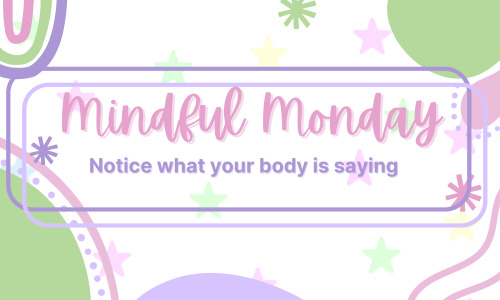
Hello everyone, I hope you all had a wonderful weekend. I'm throwing out two posts today because I wanted to get this Monday post out, and I was still feeling pretty bad yesterday. (I didn't even cook or clean all day!)
So Mindful Monday's post is going up now, and then I'll have a Tasty Tuesday for you later in the afternoon! Let's get into it, and don't forget to grab your free printable at the end!
Over the weekend, I shared my experience with heat exhaustion with you all, and I made a point to mention the mistakes that I made throughout the day on Saturday that lead to that happening. All of those mistakes boiled down to not listening to my body.
If you're neurodivergent or if you've been through trauma, you might not know - or might not remember - how to listen to your body. If you dealt with neglect early in your life or if you spent your life being told or taught that things like school or work should be your highest priority, you might struggle with this as well.
Learning how to listen to your body cues as an older teen or an adult can be tricky, but it's not impossible.
Step 1: Recognizing Physical Cues
Body cues are anything that is "off" or "out of place" with your body. If you have a long history of ignoring or not recognizing these cues, some of them may be even harder to identify because they have become constant, or you've started to recognize them as "normal" even if you probably shouldn't have. Take a moment now to think about how you're feeling physically. Do you feel any of these sensations?
Itching
Soreness
Stabbing pain
Aching
Nausea
Headache
Stomach Ache
Muscle Twitching/Spasm
Muscle Tension
Dry Mouth
Cold
Uncomfortably Warm/Hot
Skin Too Tight
Ears Ringing
Dizziness
Blurred Vision
There are a lot more possible cues of course, but this is a good list to start with. If you are feeling any of these things right now, I'd like you to get out a notebook and pen, or notes app, and jot down what you're feeling, where you're feeling it, and if you can remember then add how long you've been feeling that way.
Step 2: Recognizing Mental/Emotional Cues
Mental cues are just as important to identify a problem as physical cues, but they can also be much more difficult to pinpoint. Here's a quick list of possible cues to watch for. Just like with step 1, if you're experiencing any of these, jot them down real quick:
Racing thoughts
Anger/Hostility
Agitation
Confusion
Persistent sadness
Low energy/tiredness
Guilt
Fear/worry
Avoiding friends or family
Stress
All of these are warning signs from your mind that you are dysregulated in some way. Dysregulation happens when your emotional response or thoughts don't match up with what's happening around you. Perhaps you find yourself angry or hostile when a housemate leaves a dirty dish in the sink, or maybe you've just messaged someone and you feel guilty for bothering them, or panicky because it's been a whole minute and they haven't answered yet.
Write down the emotions or thoughts now, then move on to step 3.
Step 3: Identify the Trigger
This step can often be the most difficult, especially if you're not used to listening to your body. It's time to identify what's triggering your symptoms/body cues. Triggers can be short-term or chronic - short term triggers are ones that can be solved fairly quickly (within one day at most) and chronic triggers are often an indication of physical or mental illness. In your book/notes, go over the following questions to help start identifying your triggers.
Short-Term Trigger Questions
When was the last time you ate?
How much have you had to drink today (count all drinks, not just water)?
How many hours of sleep did you get?
Was your sleep restful or did you wake still feeling tired?
Have you spent time with friends or family recently?
Have you made time for hobbies or play recently?
When was your last shower?
What is the temperature where you are?
Chronic Trigger Questions
Do you experience frequent pains and aches?
Do you have a fever?
Do you have trouble breathing when you're sitting/at rest?
Have you been persistently sad for two weeks or longer?
Do you feel sick after eating certain foods?
Do you often see or hear things that other people don't?
Do you struggle to complete every day tasks like cooking, cleaning, hygiene routines, etc?
Step 4: Address Short Term Triggers
Your next step is to address those short term triggers. If you need to eat, drink, or sleep, take some time to do that now, or as soon as possible, then check back in with yourself in 30-60 minutes and see how you're feeling. Adjust the temperature if you can/need to, or move yourself to a location that's cooler or warmer. Take a shower as soon as you can, and make it a full service shower (scrub top to bottom, wash your hair, exfoliate, and moisturize afterward). Call up a friend or family member that you're close to and make plans to spend time together.
After taking care of all that, how do you feel? Which symptoms have cleared up and which are still persisting? If everything is good now, congrats! You're done with the exercise for the day.
If, however, you're still feeling off or unwell, carry on to the next part.
Step 5: Track Your Symptoms
If you think that you might have an ongoing condition, whether or not you want to bring it up to your doctor, tracking your symptoms might help you identify it and work out your needs to manage things.
This is going to be similar to the previous steps, but you're going to add a little more, and you're going to want to have a dedicated page in your journal/planner for this. Every day for at least 1 month, as much as you can remember, track....
The symptom
Intensity on a scale of 1-10
Duration
If you treated it and how
What you think triggered it
Any other notes/thoughts
You can use this free printable to track the frequency of your symptoms over a month, or you can grab this PDF file for a dollar for a little more in depth logging.
Have a wonderful week everyone, and I'll see you again in a few hours with a yummy recipe!
0 notes
Text
Hello everyone! I'm breaking the formula today as we observe Self-Care Sunday here.
Originally I had planned a post about having a spa day - basically a comfort/relaxation self care post.
However!
I actually have something else to talk about today, and it's something that will roll very nicely into tomorrow's Mindful Monday post. So what happened?
Yesterday I went to the flea market to work on offloading my extra belongings, and I got heat exhaustion.
Yep, you read that right. The author of a blog about taking care of yourself got heat exhaustion. So how did that happen? What did I do about it?
Nabbing a table at the flea market is a part of my weekly routine that I've been building in part to keep myself from wallowing in grief, in part to re-teach myself good customer service, and in part so that I get out of the darn house at least once a week.
Here's what yesterday's weather looked like while I was at the market:


The flea market hours are from 7am to 4pm, so as you can see, we started the day off with warm temperatures, HIGH humidity, and light breezes. The other vendors and I were all sweating by 9am.
In the afternoon, the temperature rose, as it does, and we were still dealing with over 50% humidity. Still sweating, and the breeze was still pretty light.
I was lucky enough to nab a table under a canopy, but with the breeze so light when it did blow through, the stagnant, humid air was enough even without direct sunlight.
It's very important to stay hydrated at all times, but especially so in high temperature situations. If you're sweating a lot, you're getting dehydrated, and you have to drink more to balance it out again.
And here's where I went wrong. I didn't drink more than I usually would. Part of this was that I was on my own and didn't want to leave my table multiple times to get more drinks and, inevitably, go pee. Part of it was that I didn't recognize that I was dehydrated until I was already starting to feel sick. I dozed off in my chair multiple times, and I would get up and move around to wake myself up.
As soon as I realized what was happening, I went to get two 12 ounce drinks from the concession stand, and a snack because I hadn't eaten in a few hours either. Now, I don't know if you've ever had heat exhaustion, but rehydrating in that state is a delicate balancing game, at least for myself. If I drink straight water especially, I have to take small sips every few minutes. If I drink large, or even regular sized mouthfuls, my stomach will lurch and I'll lose all that water, plus more.
So here I am, steadily downing 24 ounces of fluid and nibbling on my snack. After a few minutes, the nausea goes away and I think to myself, ah! I caught it in time and I'm fine.
And I was fine. For about 90 minutes. And then the symptoms hit me like a freight train.
Symptoms of heat exhaustion include dizziness, feeling faint, cool/clammy skin with goosebumps, blurred vision, fatigue, headache, nausea/vomiting, heavy sweating, rapid heart rate, shallow breathing, swollen feet/ankles/hands, and a drop in blood pressure when you stand.
If you've never had heat exhaustion, good. I hope you never do. I sent my mom a message that I needed to pack up and leave early, and while I waited for her to show up, I packed my totes. It was so hard, dear readers. I had to keep one hand on the table almost constantly so I didn't fall. I had to pause for several minutes at a time to just gasp for breath.
By this point, almost all the vendors around me had already left. The only ones left either didn't notice what was happening, or I was hiding it very well. Either way, a task that I normally could have completed in ten minutes took me thirty. And my mom still hadn't arrived with the car yet.
I sank into my chair and pulled up Discord to chat with some friends, and just prayed that I wouldn't completely pass out.
When my mom arrived, we loaded up the car and climbed in.
Now, I want to take a moment to tell you all that the correct thing to do when someone is experiencing heat exhaustion is move them as quickly as possible to a cooler environment, preferably an air conditioned room, provide them with plenty of fluids and loose clothes, and if they can, get them to take a cool shower. If they can't, use a mister or cool wet towels to bring their temperature down.
You should also avoid giving them fever reducing medications like acetaminophen (Tylenol) or ibuprofen. And if they aren't starting to feel better in 30-60 minutes, you want to take them to the hospital because heat exhaustion can very easily become heat stroke.
The reason I'm telling you this is because what my mom and I did was pretty much the exact opposite of all of this. Our plan was to get a room at a hotel together (it's a long story) and cool off in the AC for a while. Due to some circumstances that I don't completely remember (I was really fucking out of it by this point), we didn't go to the hotel. We went to the auto shop where my mom works, and I spent several more hours in the hot office there. They have AC there, but it's not great. We did get me a couple of cold drinks, and I drank them all, and then I spent the next few hours dozing on and off.
Sitting in that office, half asleep and miserable, I had a terrible headache and chills. My mouth was dry no matter how much I drank, and I was miserable. More than once, I thought about asking my mom to just bring me home, but we'd had plans. We were going to go swimming, and get dinner, and go see a movie. I still wanted to do those things - or rather, I wanted to want to do those things.
So even when I should have said something, I stayed quiet. We spent about six or seven hours in that office before finally going to the hotel. There, I quickly rinsed off in the shower, then so did my mom and stepdad, and instead of staying there and just resting for the night like I probably should have, I agreed to go to the movie still.
I was uncomfortable, agitated, and aggressive right up until the movie started, and even during the movie, every little thing pissed me off. Someone fell asleep mid movie and was snoring (don't do that guys, that's rude). People kept getting up and leaving. Like five people in front had their phones out with the screen brightness at max.
I felt like tearing off all my skin, I was so uncomfortable and miserable, and my mom seemed like she was getting frustrated with me, which made me more miserable.
Somehow, I made it through the movie. We went back to the hotel. I crawled into bed and promptly crashed for about 6 hours. By this morning, I felt better for the most part, but even now at 6pm, over 24 hours after getting out of that heat, I can still feel the lingering nausea and exhaustion.
I made a lot of bad choices yesterday, and I can only really blame myself for the situation that I found myself in. There was a lot that could have been done better, but that's for me to reflect on in my journal tonight.
The biggest mistake that I made however was failing to listen to my body and practice the most basic, practical self care - providing my body with food, water, shelter, and rest. I could have ended up in the hospital yesterday, and I'm grateful that not only did that not happen, but I also recovered enough to be able to share the story with you.
Now excuse me, my lovely readers, while I get a little more rest before making a healthy snack.
0 notes